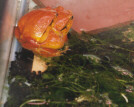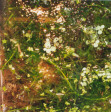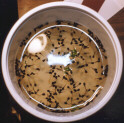










|
Tomato
Frogs Dyscophus guineti
The Tomato Frogs are represented by three generations of animals.
We have successfully reproduced Tomato frogs from generations F0
through
F2, ultimately resulting in F3 offspring. Unlike
an article seen in a major reptile magazine, all of this
reproduction
was done without the use of injectable hormones.
Offspring from all adults can be variable. We have had all three
color varieties comprising yellows, reds and oranges represented in a
single
clutch. Contrary to some publications on Tomato Frogs we have not
observed a decrease in coloration with successive generations.
Quite
the contrary has proven in our offspring. We see much brighter
reds
as opposed to maroon colored adults. Yellows and oranges are
brilliant
and not at all washed out. Our frogs are either kept in sweater
boxes
with damp sphagnum moss with a top soil base or in 10 gal glass
aquariums
with a screen top and the same substrate. Temperatures range from
a night time low of around 74 to a daytime high of 88. No direct
lighting of any type is used other than the ambient daylight in the
room.
A staple diet of crickets are fed to them every two or three days and
occasionally
a newborn pinkie mouse. We supplement with Rep-Cal with vitamin
D3
no more than once every 10 days. We also recommend you never mix
frog species or keep captive bred with wild caught of the same
species.
The benefits of keeping species separate far outweigh the problems
often
encountered when mixing them. As an
additional precaution: Ensure that ants are not present in your
home
(in or near the frog enclosure). If so, we recommend using a
non-aerosol ant bait outside of the frog enclosure to eliminate their
presence. Frogs may
succumb to
ant bite or sting if they are attacked by significant numbers of ants.

F2 male and WC female (2001)
|

Tadpole comparison
(1 week to 3 weeks)
|

Tomato Tadpoles
|

More Tomato Tadpoles
|

F2 - Tomato Frogs
|

Tomato Frog eggs
|

Tomato tadpoles
|

Tomato froglets
|

|